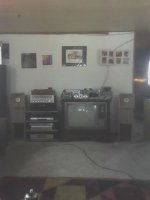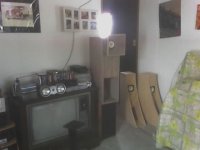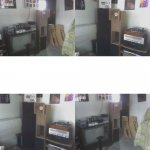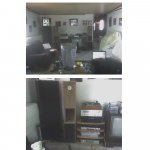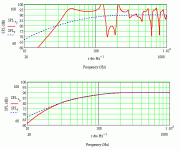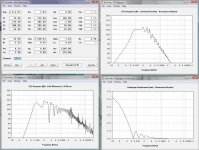David McBean said:Hornresp can model transmission line and pipe speakers provided that damping material is not included in the design.
Damping thou, is an integral part of a TL...
dave
Am I right in assuming that it could give you an idea of what you could expect from the bass, and you can then adjust damping for the desired midrange response. Or does the damping greatly affect the bass response as well?
Front horn completed!! Pics comming soon! Sound was fabulous!!
Front horn completed!! Pics comming soon! Sound was fabulous!!
It has a huge effect upon both the midrange and the LF. As you don't know much about them, I suggest you peruse here: www.t-linespeakers.org and here: www.quarter-wave.com for an introduction to the subject.
Composite horn pics
Heres the pics I promised of Dougs speakers with the addition of the front horn. Previously the bass over powered the higher mid and treble frequencies so I used hornresp to model a front horn for the 126s. I was having trouble getting one to come out well but then I remembered that hornresp assumes your driver is a flat piston and therefor doesn't model the treble response correctly so I looked at how it modeled the 126 and looked for the response to come up about 10db from 300hz up to 20000 to match the bass output of the rear horn turns out a simple conical horn did the trick. When Doug brought them over yesterday and we hooked them up to my Marantz receiver at first I was really disappointed with the sound They seemed extremely directional, didn't image well and that midrange magic seemed to be gone. Then we discovered that one of the speakerwires was connected to the driver backwards and they were out of phase. After fixing that they sounded alot better but seemed to be lacking the bass slam and dynamics I had remembered them having at Doug's shop. Then we discovered they were out of phase with my subwoofers. After that it was pure magic. The Marantz puts out 30wpc but that was far more power than these baby's needed my subs cried uncle long before the horns showed any signs of strain. Once everything was connected these babies sang like nothing I had ever heard. Now that we have the utmost confidence in Hornresp and Fostex drivers it's time to get really creative and make some art!!
Heres the pics I promised of Dougs speakers with the addition of the front horn. Previously the bass over powered the higher mid and treble frequencies so I used hornresp to model a front horn for the 126s. I was having trouble getting one to come out well but then I remembered that hornresp assumes your driver is a flat piston and therefor doesn't model the treble response correctly so I looked at how it modeled the 126 and looked for the response to come up about 10db from 300hz up to 20000 to match the bass output of the rear horn turns out a simple conical horn did the trick. When Doug brought them over yesterday and we hooked them up to my Marantz receiver at first I was really disappointed with the sound They seemed extremely directional, didn't image well and that midrange magic seemed to be gone. Then we discovered that one of the speakerwires was connected to the driver backwards and they were out of phase. After fixing that they sounded alot better but seemed to be lacking the bass slam and dynamics I had remembered them having at Doug's shop. Then we discovered they were out of phase with my subwoofers. After that it was pure magic. The Marantz puts out 30wpc but that was far more power than these baby's needed my subs cried uncle long before the horns showed any signs of strain. Once everything was connected these babies sang like nothing I had ever heard. Now that we have the utmost confidence in Hornresp and Fostex drivers it's time to get really creative and make some art!!
Attachments
Where'd everybody go?
Oh well. Looks like Doug's hearing is alot more sensitive than mine. He and his son Daniel discovered that the horns drop off quite a bit above 13k or so. Anybody have any solutions to this problem other than an eq or a supertweeter(we're already considering them both but would love to hear other suggestions) I suppose you could attenuate everything below that with a filter but who wants to use a filter? I'm wondering if suspending a smaller horn inside the front horn would do anything for the HF. I'm guessing that the lack of pressure behind it would eliminate it's effectiveness, but I don't really know. So any ideas would be appreciated. I just love the Idea of a fullrange single driver speaker running at 105db or so but I don't think missing the top octive or so is a trade off most people would be willing to make.
Oh well. Looks like Doug's hearing is alot more sensitive than mine. He and his son Daniel discovered that the horns drop off quite a bit above 13k or so. Anybody have any solutions to this problem other than an eq or a supertweeter(we're already considering them both but would love to hear other suggestions) I suppose you could attenuate everything below that with a filter but who wants to use a filter? I'm wondering if suspending a smaller horn inside the front horn would do anything for the HF. I'm guessing that the lack of pressure behind it would eliminate it's effectiveness, but I don't really know. So any ideas would be appreciated. I just love the Idea of a fullrange single driver speaker running at 105db or so but I don't think missing the top octive or so is a trade off most people would be willing to make.
planet10 said:Damping thou, is an integral part of a TL...
Scottmoose said:It is rather important.
Hi planet10 and Scottmoose,
I would have to agree with you there
I was really just thinking that Hornresp can accept a negative taper, have an offset driver, and identify the resonances that perhaps need damping
Kind regards,
David
Fair point David; FWIW, I'd say it's possible to design a TL empirically in Hornresp, but you'd have to be careful. Just make sure you're going for loads of gain with the undamped pipe, because that is going vanish rapidly with the addition of viscous damping. For e.g. top of attached = undamped QW pipe, bottom = same, damped to become a TL.
Better yet would be to size your pipe with Martin's alignment tables, then run it through Hornresp for a graph etc of the undamped line as required. Takes some of the guesswork out of it.
Better yet would be to size your pipe with Martin's alignment tables, then run it through Hornresp for a graph etc of the undamped line as required. Takes some of the guesswork out of it.
Attachments
I said his alignment tables, not his MathCAD worksheets. http://www.quarter-wave.com/TLs/Alignment_Tables.pdf
And an Excel file based on these, just to make it easier: http://www.quarter-wave.com/TLs/Alignment_Tables_Calculator_3_3_09.xls
And an Excel file based on these, just to make it easier: http://www.quarter-wave.com/TLs/Alignment_Tables_Calculator_3_3_09.xls
Glad they're of use.
Without seeing the design, I can't really contribute anything that'd be particularly worth reading. FWIW though, considering the back-horn, you appear to have tuned to a relatively high frequency rather than attempting to squeeze ultimate extension out of it, which is usually quite a good idea. If, as it sounds, it's a high-gain design, then mating to a front horn to form a compound design is also a good idea if done correctly. Conical is usually my own favourite for the latter, given it's lack of distortion. Just keep an eye on driver excursion, the 126 has very little linear travel.
Without seeing the design, I can't really contribute anything that'd be particularly worth reading. FWIW though, considering the back-horn, you appear to have tuned to a relatively high frequency rather than attempting to squeeze ultimate extension out of it, which is usually quite a good idea. If, as it sounds, it's a high-gain design, then mating to a front horn to form a compound design is also a good idea if done correctly. Conical is usually my own favourite for the latter, given it's lack of distortion. Just keep an eye on driver excursion, the 126 has very little linear travel.
5" atd veravox5x and 5s to a lesser extent because of a dip.brsanko said:does anyone know of any 4.5" drivers that have a rising FR above that point?
3" fostex ff85k
8" tang-band w8-1808 www.tb-speaker.com/detail/1230_04/w8-1808.htm
- Status
- This old topic is closed. If you want to reopen this topic, contact a moderator using the "Report Post" button.
- Home
- Loudspeakers
- Full Range
- first try at designing our own horns
